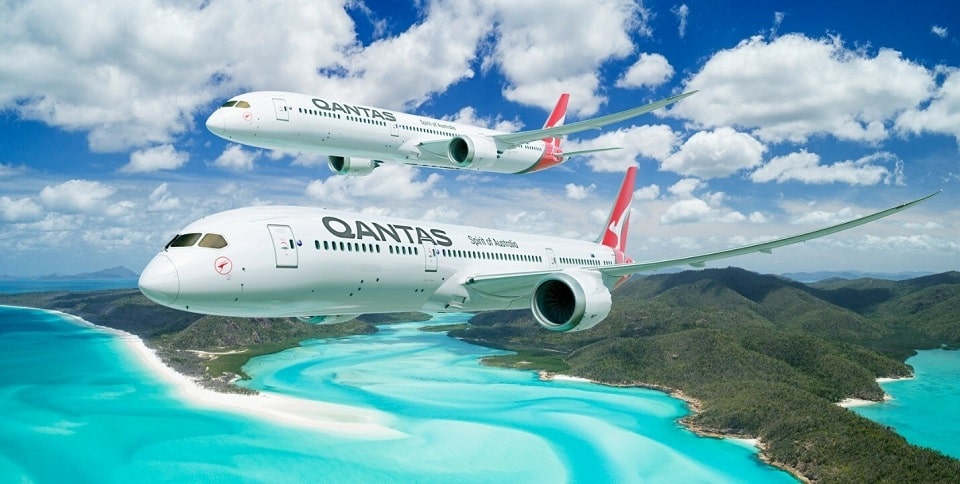Airlines
Qantas places orders for new aircraft from Airbus and Boeing

- Firm order for 12 Airbus A350 and 12 Boeing 787 aircraft.
- Additional purchase right options for renewal and growth.
- Provides replacement for current A330 and A380 fleets over 10-plus years.
- Deal includes access to up to 500 million litres of sustainable aviation fuel; enhancing pathway to reach the Group’s 2030 emissions targets.
The Qantas Group has revealed the final part of its jet fleet renewal program, with a definitive order for 24 aircraft to gradually replace its existing A330s.
The multibillion-dollar purchase is split between 12 Airbus A350s and 12 Boeing 787s, with deliveries beginning in FY27 and continuing into the next decade. The Group has also acquired further purchase rights, split evenly between both manufacturers, to provide flexibility for future development and eventually replace its 10 A380s with A350s from roughly FY32 onwards.
Qantas and Airbus Partnership for the biofuel industry.(Opens in a new browser tab)
The A330 aircraft of Qantas mostly fly on international routes to Asia and the US as well as a few domestic routes. The 787 and A350 aircraft will be able to operate all of the routes on the airline’s present international network in addition to opening up new ones because of their extended range when they are delivered.
In keeping with the Group’s regular replacement profile, Qantas’ A330 fleet will have an average age of 21 years when the replacement programme begins in FY27. From FY25 onward, aircraft slated to depart the Qantas fleet at the end of the replacement programme will receive a cabin upgrade, including next-generation seats in the Economy class.
QANTAS SIGNS SECOND MAJOR SUSTAINABLE FUEL DEAL(Opens in a new browser tab)
Qantas will have access to up to 500 million litres of Sustainable Aviation Fuel (SAF) annually beginning in 2028 as part of the agreement with both Airbus and Boeing. This might help the Group achieve up to 90% of its 2030 intermediate SAF objective. SAF is a crucial component of Qantas’ emissions reduction strategy because it offers a direct replacement for conventional jet kerosene while reducing lifecycle carbon emissions by up to 80%.
Based on meeting certain criteria under Airbus and Boeing deals, including partnership with the manufacturers on SAF projects. The agreement includes ~80 million litres of SAF per annum from existing projects. The remaining volume will be sourced through investment in new projects.

Airlines
Air India Rolls Out A350s for Delhi-New York JFK and Newark Routes

In a major development for North American travelers, Air India has announced the deployment of its state-of-the-art Airbus A350-900 aircraft on two key routes: Delhi to New York and Delhi to Newark.
The service on the Delhi-New York route will commence on November 1, 2024, while the Delhi-Newark route will see its inaugural flight on January 2, 2025.
The introduction of the air india a350 will bring significant enhancements to Air India’s offerings, particularly with the launch of its Premium Economy class. air india retrofit This new class will feature 24 wide seats arranged in a 2-4-2 configuration, providing passengers with extra legroom and a more comfortable flying experience.
Soon, Air India aircraft will feature onboard WiFi & all-new cabins: Click here
“We are encouraged by the positive guest feedback we have received from the domestic deployment of our air india a350 interior to offer our hero product on the Delhi-New York JFK and Delhi-Newark routes. This is a significant leap forward for our U.S. operations that also underscores our commitment to continuous improvement,” said Campbell Wilson, Chief Executive Officer & Managing Director of Air India.
The A350’s Business class will set new standards with 28 private suites, each equipped with full-flat beds, direct aisle access, and personal wardrobes. Economy class will be configured to accommodate 264 passengers in a 3-4-3 layout. Across all cabins, passengers will enjoy the latest Panasonic eX3 in-flight entertainment system, offering over 2,200 hours of content.
Air India’s First A350-900: Interior, Routes, &Inflight Features: Click here
This strategic deployment marks a notable enhancement in Air India’s U.S. operations, with 60% of its flights to the U.S. now featuring new or upgraded cabin interiors. The air india new international routes currently operates 51 weekly flights to five U.S. destinations: New York JFK, Newark, Washington DC, Chicago, and San Francisco.
The revamped cabins, advanced in-flight entertainment systems, and improved service standards represent air india wifi commitment to providing a superior travel experience. “We believe this enhanced offering will solidify Air India’s position as a leading carrier and attract travellers seeking a world-class flying experience between India and the United States,” the airline stated.
Seats on these flights are now available for booking on Air India’s website, mobile app, and through travel agents, ensuring that passengers can easily plan their journeys on these newly upgraded routes.
Air India Economy vs Qatar airways economy: which is best?:Click here
-

 Travel1 week ago
Travel1 week agoAir India to Expand US Operations with Three New Routes After a Decade
-

 Travel2 weeks ago
Travel2 weeks agoWhy We Should Avoid These Stamps in a Passport
-

 Airlines1 month ago
Airlines1 month agoInvestigations Reveal Fake Chinese Titanium in Boeing and Airbus Jets
-

 Tech4 weeks ago
Tech4 weeks agoChina’s CATL Plans 1,800-Mile Electric Plane Launch by 2027
-

 Airport3 days ago
Airport3 days agoTop 10 Largest Airports in the World by Size
-

 Aerospace4 weeks ago
Aerospace4 weeks agoChina’s Fighter Jets Turn Wings into Autonomous Drones
-

 Airlines4 days ago
Airlines4 days agoAir India Rolls Out A350s for Delhi-New York JFK and Newark Routes
-

 Defence3 weeks ago
Defence3 weeks agoBoeing Enhances Chinook with New Engines and Block II Upgrades at $96 Million







